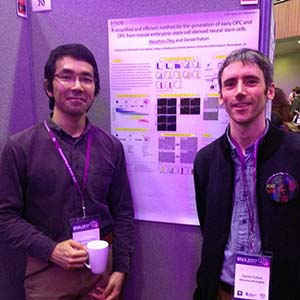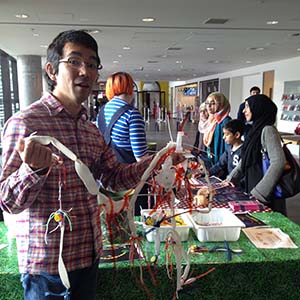These pages provide updates and news from the STEM-ZAP project.
STEM-ZAP is the acronym for a project funded through the Marie Skłodowska-Curie scheme entitled ‘Optogenetics based discovery of new pathways towards stem-cell mediated myelin repair’.
Project overview
Neurological disorders, such as multiple sclerosis, that involves degeneration of the myelin sheath exact a social and economic toll on the EU estimated at 14.6 billion Euros per year. Consequently therapies capable of regenerating damaged myelin are an important clinical goal. This project aims to develop new strategies for the replacement of myelin through the use of embryonic stem (ES) cells. This work will seek novel ‘pro-myelination’ signalling molecules capable of driving the generation of oligodendrocytes from ES cells.
To do this the project exploits the developmental impact of membrane depolarisation. Depolarisation enhances myelination during postnatal development, and promotes the differentiation of ES cells. Although depolarisation represents a valuable tool for promoting myelin formation, its potential to drive the generation of oligodendrocytes from ES cells (ES-OL) has not been explored. Similarly, the ‘pro-myelination’ signals coupling neuronal activity and depolarisation to oligodendrocyte development remain unknown. Filling these gaps has the potential to deliver new methods for increasing the supply of pro-myelinating OL capable of regenerating damaged myelin.
This project is using optogenetic stimulation, novel methods of ES-derived oligodendrocyte cultivation, high-throughput screening, and transcriptomic analyses to identify novel signalling pathways involved in the generation of myelinating oligodendrocytes.
Project progress
1. STEM-ZAP task 1.1 requires development of a new methodology for driving the generation of oligodendrocytes from ES cells
We have adapted the Neural Stem Sphere (NSS) protocol to enable the efficient generation of oligodendroglial lineage cells. The NSS method has already been established as a simple and effective way to generate high-purity neuronal cultures from mouse and human ES cells, and work in the first phase of this project has determined the culture conditions required to direct NSS-derived cells towards the oligodendroglial lineage (see below). Our data indicate that we are able to progenitor cells showing many of the hallmarks of OPC. This data was recently presented at the BNA Festival of Neuroscience (see Outreach and communication).
2. As part of Task 1.1 we commissioned the production of two lentiviral vectors for the delivery of a Channel Rhodopsin 2 (ChR2)-mCherry transgene to ES cells and NSS-derived oligodendroglial lineage cells. ChR2 is a bacterial cation channel whose specific activation by blue light induces membrane depolarisation. mCherry is included to allow analysis of transgene expression using methods such as flow cytometry and immunofluorescence, and to allow tracking of transduced cells in ex vivo and in vivo experiments. Two vectors were produced using different promoters to drive expression of the ChR2 transgene since optimal promoters for these NSS derived cells could not be predicted. To date we have established stable lines of NSS derived OPC expressing ChR2mCherry and are in the process of validating functional expression of the ion channel using calcium imaging methods. We plan to present this data at the upcoming EuroGlia meeting (see Outreach and communication).
3. In Task 1.2 we plan to confirm the integration and development of NSS-derived OPC in brain slice cultures. For this we are using cerebellar slices since they provide an ideal system for examining oligodendrocyte differentiation and myelination. NSS-derived cells are being transplanted into slice cultures, and their survival and development examined by standard immunofluorescent assays of oligodendrocyte development and myelination. We will also be testing the differentiation of NSS-OPC in vivo using rodent model systems available at the University of Birmingham.
Next tasks:
We expect to complete functional validation of the new NSS-derived ChR2 expressing OPC lines by mid-July, after which we will begin to explore optimal patterns of blue light stimulation for OPC differentiation (Task 1.3), before examining the effects of this stimulation on OPC differentiation in ex vivo and in vivo models (Task 1.4).
Outreach and communication:
STEM-ZAP involves a number of Outreach Activities (OA) that were planned to develop the science communication skills of the Marie Curie Fellow (Dr Masa Otsu) and to communicate the findings arising from the project – this web page is one of them (OA3 in the proposal). Recently Dr Otsu has presented data from Task 1.1 at the British Neuroscience Association Festival of Neuroscience (Birmingham, April 2017), and also helped with Build-a-brain, an interactive workshop where children learnt basic principles of neural circuits through the act of crafting different types of neurons. Dr Otsu will be presenting findings from Task 1.2 at the EuroGlia meeting in Edinburgh (July 2017). This data will describe the new NSS-derived OPC lines expressing ChR2mCherry transgenes.

